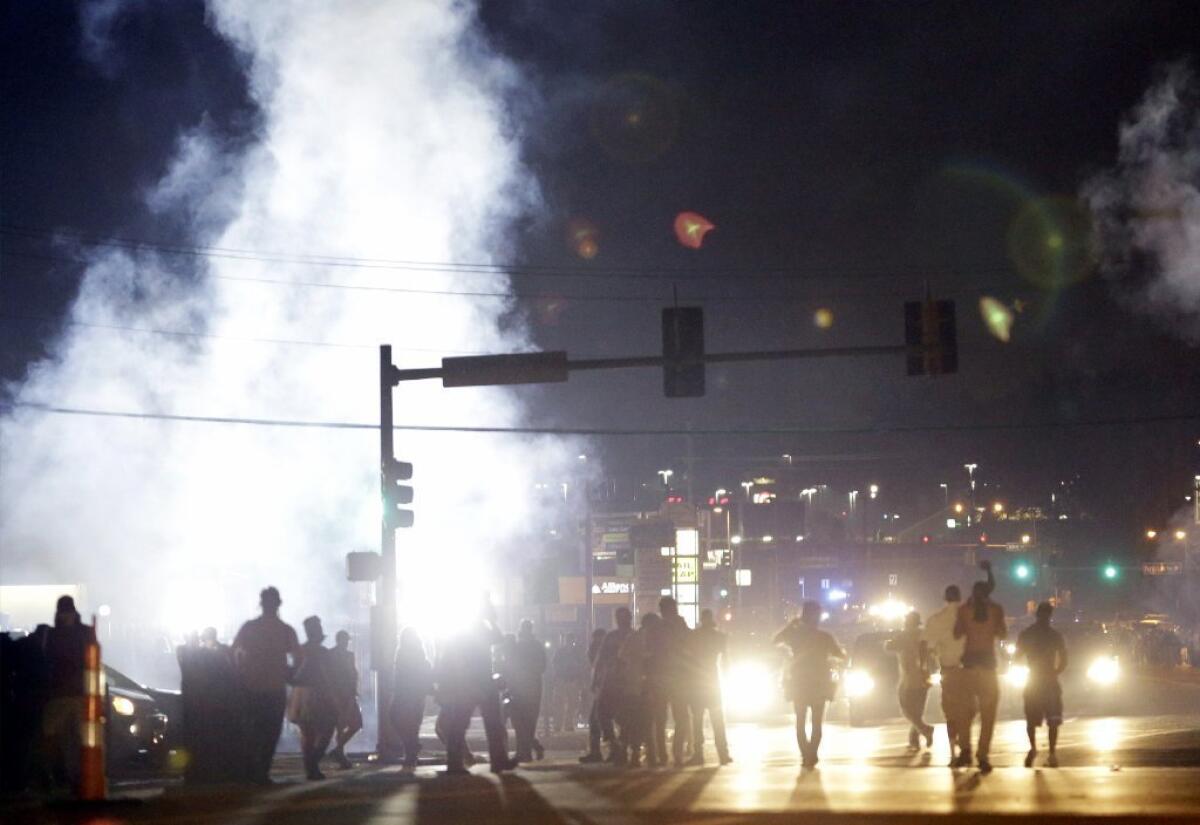Officials deny Ferguson no-fly zone was designed to keep out media

- Share via
Police and aviation officials denied a report Sunday that they ordered a no-fly zone over Ferguson, Mo., this summer in order to keep news helicopters away from the protests that formed after a police officer killed an unarmed man.
St. Louis County police said in a statement that they requested the restricted airspace for safety after police helicopters came under fire. But recordings of Federal Aviation Administration officials’ conversations, obtained by the Associated Press, appeared to cast doubt on that as the sole rationale.
Media helicopters kept their distance from one of the most significant news stories of the year, where activity on the ground was marred by concerns over police restrictions on freedom of the press after the Aug. 9 shooting of Michael Brown, 18.
It turns out the media were not barred from flying over the St. Louis suburb after all: They simply assumed they were. And that may have been intentional.
The Associated Press report -- drawn from recordings the AP obtained of phone calls between Federal Aviation Administration officials -- included several quotes from officials candidly discussing why a no-fly zone had been instituted over Ferguson.
The predominantly black suburb of St. Louis had been enraged by the police shooting of Brown by white officer Darren Wilson. The ensuing protests also drew intense scrutiny after police arrested dozens of demonstrators and a few journalists.
A strict no-fly restriction initially was put in place over the city for 14 1/2 hours, designating it as an aerial hazard area. That came after police said their helicopters were coming under gunfire from the ground.
But according to the recordings obtained by the AP, after drafting a modification to allow commerical flights to continue using nearby Lambert–St. Louis International Airport, aviation officials reflected that local police seemed very interested in keeping out news choppers. (Flight restrictions ultimately lasted 11 days.)
“They finally admitted it really was to keep the media out,” said one FAA manager of the St. Louis County Police Department’s requests for the no-fly zone, according to the AP’s review of the recordings, which were obtained under the Freedom of Information Act.
An unidentified FAA manager at the FAA’s Kansas City center said police “did not care if you ran commercial traffic through this TFR [temporary flight restriction] all day long. They didn’t want media in there,” according to the AP.
A male FAA manager asked at one point, “So are [the police] protecting aircraft from small-arms fire or something? Or do they think they’re just going to keep the press out of there, which they can’t do?”
In a statement provided to the Los Angeles Times on Sunday, St. Louis County Police spokesman Sgt. Brian Schellman said, “The St. Louis County Police Department reaffirms the reason the request for restricted airspace was made was due to the hostile nature of certain persons on the ground that fired gunshots at the police helicopter, as well as used a laser device pointed at the police helicopter.
“The pilots made the decision to request that all aircraft, not just media aircraft, be restricted for the safety of those using that airspace,” Schellman added in the statement.
But media were still allowed to enter with permission, according to the specific category of flight restriction ultimately secured by police. Under that restriction, FAA rules allow aircraft to enter the no-fly zone if “the aircraft is carrying properly accredited news representatives, and prior to entering the area, a flight plan is filed.”
No news outlet is known to have done so, and on Sunday, the FAA didn’t want to be blamed.
“FAA cannot and will never exclusively ban media from covering an event of national significance, and media was never banned from covering the ongoing events in Ferguson in this case,” FAA Administrator Michael P. Huerta said in a statement provided to the Los Angeles Times.
Huerta said that “when requested and no safety or security issues exist, the FAA actively facilitates media access to airspace,” adding, “To the best of our knowledge, during the 11-day period flight restrictions of varying levels were in place, no media outlets objected to any of the restrictions.”
But confusion could have been the point, at least according to one FAA official speaking about the modified Ferguson no-fly zone on the recordings obtained by the AP: “A lot of the time the [lesser restriction] just keeps the press out, anyways. They don’t understand the difference.”
In another exchange captured on the audio obtained by the AP, an FAA official is explaining to a police official how the modified no-fly zone would allow flights to use Lambert-St. Louis International Airport while effectively keeping the media away.
The order allows “aircraft on final [approach] there at St. Louis. It will still keep news people out. ... The only way people will get in there is if they give them permission in there anyway so they, with the [lesser restriction], it still keeps all of them out.”
“Yeah,” replied the police official, according to the AP. “I have no problem with that whatsoever.”
Brian Thouvenot, news director for KMOV-TV in St. Louis, told the Los Angeles Times that he’d thought about fighting the no-fly zone until he found out he could fly over the scene at a height of 3,000 feet. “There was so much going on, we just kept moving forward,” he wrote in an email.
But Thouvenot didn’t know that the media could have simply filed a flight plan to enter Ferguson. “No one told us,” he said.
Follow @MattDPearce for national news
More to Read
Sign up for Essential California
The most important California stories and recommendations in your inbox every morning.
You may occasionally receive promotional content from the Los Angeles Times.











